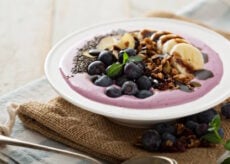What Does It Mean When You Are Craving Chocolate?

Whether you see yourself as a chocoholic or just find yourself occasionally craving chocolate (say, every afternoon), you’re not alone. Sure, there are allegedly people who don’t like chocolate (gasp!), and others are sadly allergic, but they tend to be very much in the minority. So, why do so many of us crave chocolate? And, should we allow ourselves to give in?
Before you stop reading right here, fearing we’ll tell you chocolate can’t be part of a healthy diet, don’t worry. There are good reasons—including health benefits—to keep eating chocolate. Rather, it’s important to look at why you’re eating it, how you’re eating it, and perhaps how much you’re consuming.
Why is Craving Chocolate So Common?
According to research, “Chocolate is the most frequently craved food in Western societies.” 1 Is it because chocolate just tastes so darn yummy? Or are there other reasons we find reasons to add chocolate to nearly every celebration (from birthdays to Halloween, Christmas, Valentine’s Day, Easter, anniversaries, Mondays, and more)?
Food cravings, in general, are very common. They can indicate we’re not getting enough of key nutrients. For instance, research has found that compulsively chewing on ice chips may indicate an iron deficiency. 2
In most cases, though, food cravings are for calorie-dense, highly palatable foods, rather than vegetables, fruits, quality proteins (or ice, for that matter). Cravings are susceptible to a complex dance of hormones and other chemicals in the brain and body. And eating foods that are higher in sugar or fat releases neurotransmitters, which translates to pleasure and reward and can even increase future cravings for that food.
Humans evolved to desire foods that are higher in sugar and fat. The sweeter the fruit, for instance, indicates it’s at its peak in terms of freshness and nutrient content. And higher fat foods provide the energy needed when food is less available. These were both important variables as we evolved from our hunter/gather ancestry when food wasn’t as easy to come by. Food cravings can also be due to psychological reasons, including habits, emotions, or stress. 3
All of this explains why we tend to crave processed or junk foods like a calorie-dense chocolate bar over a bowl of broccoli after a long, stressful day, uncomfortable conversation, or otherwise challenging experience.
10 Reasons We Crave Chocolate
The positive boost you get from eating chocolate isn’t all in your head. We’ve all evolved to seek out foods like chocolate. In addition, there are specific reasons why many of us find chocolate so irresistible. For example…
1) You’re simply hungry and want something delicious, convenient, and satisfying. This is especially true if you’ve waited too long between meals and your blood sugar levels have dropped.
2) Your energy levels are low. Chocolate provides the double benefit of sugar with caffeine to recharge your diminished levels.
3) You’re craving sugar rather than chocolate and just want any sweet treat, and chocolate is convenient.
4) It’s your go-to habit as a quick reward, break, or when stressed due to its mood-boosting effects. Chocolate has also been shown to increase serotonin levels, which is a neurotransmitter associated with feelings of pleasure. Over time, this habit can even change your brain chemistry to make the pull for chocolate even stronger.
5) You’re bored, and chocolate provides a nice diversion from the same old, same old.
6) Hormonal fluctuations, such as with menstruation, pregnancy, or stress, can also lead to chocolate cravings or cravings for other foods that are higher in sugar or fat.
7) You feel sad, stressed, or anxious as chocolate may temporarily soothe those uncomfortable feelings. Dark chocolate, in particular, can release chemicals known to boost mood along with endorphins, which help reduce stress and anxiety.
8) You’re celebrating—whether it’s a birthday, wedding, graduation, shower, etc., chocolate is often the go-to festive food.
9) You associate chocolate with happy memories.
10) This one is debatable, but it may indicate you’re deficient in magnesium. Of course, there are other foods higher in this nutrient, such as pumpkin seeds, quinoa, spinach, or avocado. 4 – 9
Curbing Chocolate Cravings
There is nothing wrong with indulging in an occasional piece of dark chocolate or including cocoa powder in a recipe (such as chocolate cream cheese truffles, peanut butter cup protein mug cake, or dark chocolate pomegranate bark). But if you find that your chocolate cravings are interfering with your health or physique goals—especially if one piece leads to consuming a whole bar daily, there are steps you can take to help curb your cravings, such as:
1. Wait It Out
Cravings tend to pass after 15 to 20 minutes. So, if you realize the chocolate is something you don’t want or need (at least right now), you can often just press pause and let the craving naturally pass. In the meantime, find something else to do, such as take a walk, chat with a friend, play with a pet, read a good book or favorite blog, or listen to a podcast.
2. Adjust Your Scents
Food cravings can be affected by our other senses, especially smell. In one study, women who inhaled sweet scents (such as vanilla) found their chocolate cravings increased. Those who inhaled a fresh scent (such as citrus or eucalyptus), on the other hand, found the craving dissipated. 10
3. Eat Mindfully
Go ahead and give in to the craving, but do so slowly, intentionally, and mindfully, allowing yourself to focus on the food—the taste, texture, mouthfeel, and how the food makes you feel rather than mindlessly eating without realizing what or how much you’re consuming. This can help you enjoy chocolate in the moment without going way over how much you intend to eat.
4. Savor Some Succulent Fruit
Give your tastebuds something sweet with a natural sugar fix combined with fiber to prevent a rush of blood sugar. As a bonus, you’ll also be getting plenty of nutrients that promote energy. Some of the best sugar-crushing options include grapes, watermelon, mangoes, and cherries.
5. Stay Hydrated
It’s easy to mistake thirst for hunger. Simply sipping on water throughout the day may help reduce your appetite and cravings for not only chocolate but other enticing foods.
6. Power Up Your Protein
If you find you’re reaching for chocolate every afternoon after lunch to combat an afternoon slump, you may need to eat something that fills you up for longer and doesn’t lead to a carb crash after lunch. Try foods that are higher in protein, which provide more satiation and help stabilize blood sugar levels. Some top options include Greek yogurt (perhaps with some chocolate protein powder mixed in), hard-boiled eggs, cottage cheese, or tuna salad.
7. Choose a Lighter Snack
Especially if you reach for chocolate out of habit or hunger, you may get just as much enjoyment from a lighter, more nutrient-dense snack like:
- Air-popped popcorn
- An apple or celery stalks with a slight smear of nut butter
- Sliced veggies with a Greek yogurt or hummus dip
- Olives
- Avocado toast
You can also choose to include more fiber, protein, and nutrients in your baked goods, like lemon zucchini bread, so they’ll help fill you up for longer.
8. Get Caffeinated
Looking for a boost of energy, especially after you’ve already eaten? You’re not hungry, so you don’t need more calories. In that case, an afternoon (or mid-morning) cup of joe or caffeinated tea may give you the lift you’re looking for without any calories. (If you don’t like your coffee or tea black, a tablespoon of half and half only adds 20 calories.)
LIMITED TIME OFFER: Get Ageless Turmeric, Our Highly-Bioavailable Turmeric & Ginger Supplement, As Low As $14
9. Eat Enough Magnesium
It is debatable whether or not we crave chocolate due to low levels of magnesium. But we do know most Americans don’t get enough of this important mineral, and this can lead to muscle aches and cramps, fatigue, sleep issues, increased anxiety, high blood pressure, and other issues. While chocolate does provide a small amount of magnesium, other foods that provide even more include nuts like almonds, cashews, Brazil nuts, and peanuts.
10. Enjoy Your Chocolate
Sometimes there’s no substitute for chocolate. It’s often better to intentionally choose to eat your favorite foods than trying to resist—only to lose all control. To take advantage of the bigger health benefits the cacao fruit provides, avoid those products that are mostly sugar, fat, and other additives, and instead choose:
- Dark chocolate with 70% or more chocolate, which leaves less room for sugar and provides higher levels of antioxidants.
- Cocoa powder, which provides that amazing chocolate flavor without any added sugar or fat. It can be added to smoothies as well as included in healthy, rich, chocolaty recipes. Per tablespoon, it adds up to just 12 calories with 3 grams of carbs, 1 gram of protein, 1 gram of fat, and 2 grams of fiber with several healthy minerals.
- Cocoa nibs offer an intense chocolate flavor with plenty of crunch. They are also minimally processed and a rich source of fiber, magnesium, iron, and manganese. If you make a smoothie bowl, a bowl of fruit topped with Greek yogurt, chocolate avocado pudding, or oat energy bites, consider topping it with nibs to tame your chocolate cravings.
What’s more, these types of chocolate are rich in polyphenols, which have been shown to support heart health and brain function by promoting healthy levels of inflammation.
And if you choose to just eat your favorite milk chocolate, remember to watch the serving sizes as it’s easy to just keep taking bite after bite of that amazingly creamy goodness without ever really filling up.
Craving Chocolate Takeaway
Whether you’ve just gotten some bad news, you experienced a restless night of sleep, you’re in an afternoon slump, or just want a sweet treat, it’s easy to reach for a chunk of chocolate to help you through the moment.
There are health benefits of the polyphenols found in chocolate, such as helping regulate blood pressure, promoting cognition and mood, and even decreasing the risk for diabetes.11 – 13 So, it’s not something you have to leave off the menu.
But if chocolate triggers to you go a little crazy or if the cravings are interfering with your goals, there are ways to reign it in and help reduce your cravings. And there are many ways to eat chocolate without all the refined sugar and refined fats that can be detrimental to your physical and mental health to have your chocolate and eat it too.





 US Doctor: "Eating This Every Day Can Snap You Into Ketosis"
US Doctor: "Eating This Every Day Can Snap You Into Ketosis" 3 Key Nutrients to Help Lubricate Your "Tin Man" Joints
3 Key Nutrients to Help Lubricate Your "Tin Man" Joints AVOID Plant-Based Protein Powders (unless...)
AVOID Plant-Based Protein Powders (unless...)

